- Home
- About us
- Blog
- Shop
- Brands
- ALL Brands List
- Analog Relax
- Antipodes Audio
- Audio Solutions
- AudioByte
- AudioCircle
- Audiomica Laboratory
- Canary Audio
- Canor Audio
- Chameleon Audio
- Dan D'agostino
- Eversolo
- Ferrum Audio
- Fezz Audio
- Glanz
- HiFiMAN
- HoloAudio
- LAB 12
- LAIV
- LampizatOr
- Magico
- Mega Acoustic
- Monrio Audio
- Origin Live
- Phasemation
- Pink Faun
- PLiXIR
- Qualiton
- Reed
- Remton
- Revival Audio
- Riviera Audio
- Rockna Audio
- Sbooster
- Shelter
- Sigma Acoustics
- Signal Projects
- SOtM Audio
- SPEC
- Takatsuki
- Takumi
- Tedeska
- Tellurium Q
- Trafomatic Audio
- Tsakiridis Devices
- Volumio
- Sales
- Second Hand Deals
- Account
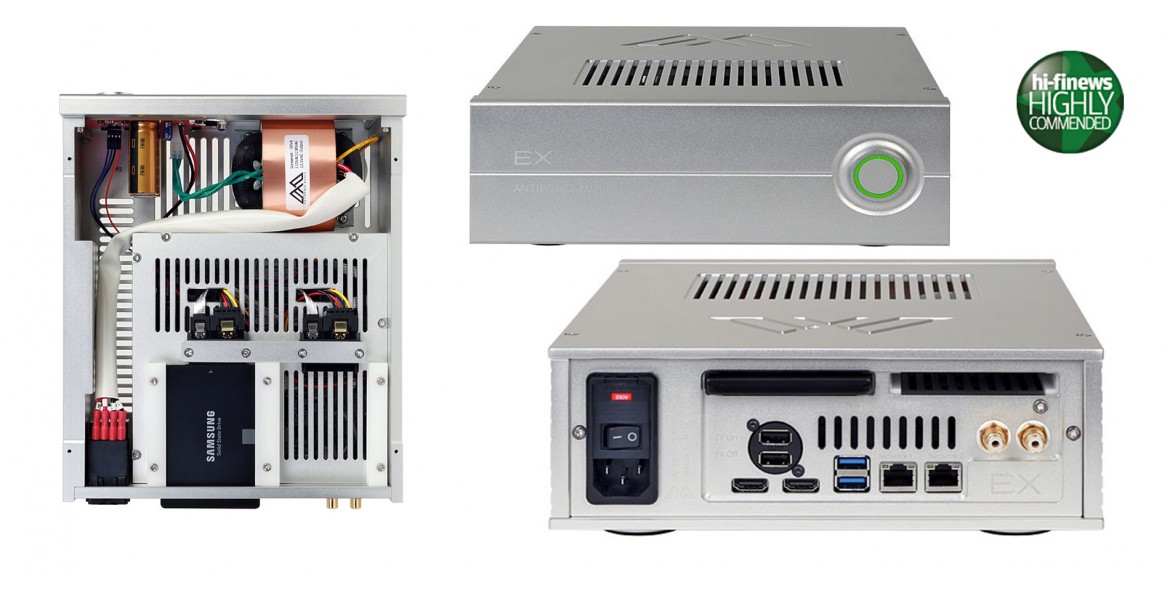
Antipodes Audio EX Music Server/DAC
This ‘music server’ is rather more than it might initially appear, and you can apparently use it alone, or with another music server model, the CX. So what’s that all about? One soon comes to realise that, in the new world of computer-based music playback, nothing is quite what it seems. What’s more, the terminology used to describe the products designed to make it possible seems almost wilfully imprecise. New Zealand-based Antipodes Audio doesn’t help too much, for its £4080 EX, available in silver or black, may say ‘Music Server’ on the front, but in fact it’s rather more than that. It combines the functions of storage, serving, rendering and digital-to-analogue conversion all in one box. The upshot is that this means you could use it as a purely Ethernet source to feed an external player/renderer or as a client for an external network store. Or you might use it as an all-in-one digital transport to feed a USB DAC with files at up to 768kHz/32-bit and DSD512, depending on the DAC’s own capabilities, or even as a complete player, with analogue output straight into an amp or preamp.
Custom Build
If all that doesn’t have you going all spinny-headed, you can also use the EX together with the company’s £5720 CX, which by the way also says it’s a ‘Music Server’, creating a £9655 combination Antipodes says is ‘jaw-droppingly superior’ to any product it has previously offered. This set-up takes advantage of the fact that each unit can be customised by the activation of a variety of onboard apps. In the CX/EX combination, the former only runs the server app, allowing the EX to function just as a renderer/client – and with a direct Ethernet between the two, rather as is the case when a Melco server is used to supply music to network player, a high degree of isolation from interference is claimed. There are also the benefits of each unit being optimised for its task. The idea is that you can buy one unit or the other, and then build to the full CX/EX system, which Antipodes says will give better results than, say, using one of the two connected via USB to an external DAC. And as each unit is built into half-width (24cm wide) casework, the two could be used side by side, or indeed stacked.
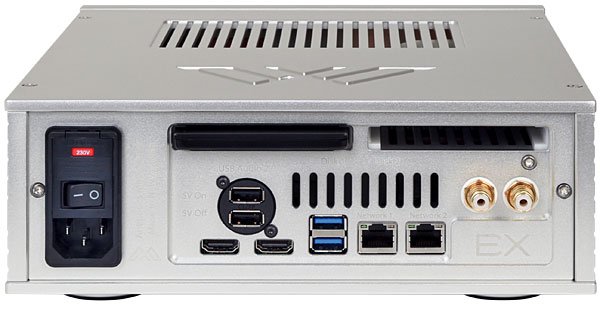
While the two Antipodes units are fairly similar, there are differences. The CX has a more powerful processor run at a low clock-rate to reduce noise, and enhanced ‘heat pipe’ cooling, meaning that it’s optimised for use as a Roon Core with all its DSP and transcoding capability, including taking PCM files all the way up to DSD512. The EX we have here, meanwhile, has that built-in digital-to-analogue conversion able to handle files up to 192kHz/24-bit as well as DSD using the DoP protocol. It transcodes other formats down to suit the onboard conversion, opening up another ‘get you started’ option before you consider adding a USB DAC, using the CX as a lower-powered network music server, or going the whole CX/EX route.
Slot Machine
Both models offer a choice of onboard storage capacities – users can install SSDs up to a total of 8TB, with Antipodes recommending Samsung EVOs for the task. These drives just push into slots found at the rear of the unit, and are then set up using a routine in the web-based interface for the EX, which is also used to determine which apps are run to provide the server functions. Files can be added to the installed discs using drag and drop from a computer on the same network, or you can plug a CD drive into one of the multiple USB ports on the rear of the EX. I used the same inexpensive Samsung drive I have connected to my computer for the odd CD rip, but Antipodes will also sell you a high-precision drive, the £850 P1.
It’s isolated inside a solid block of aluminium and works with the ripping software built into the EX to allow auto-ripping. Simply insert a disc and it’s read, ripped, stored and then finally ejected. In essence, the EX – the company’s most affordable model – is the earlier DX shrunk down to half-width, with the main specification change being in the area of the power supplies. The EX replaces the DX’s dual ODAPS1 linear supplies with a single ODAPS2, which the manufacturer says gives it improved performance as a renderer at the expense of some server capability – not that I noticed any problems in this respect with the EX used in dual-function mode. However, what did irritate me a bit is that Antipodes follows the current trend of only providing the operating manual for the EX in online form. Yes, I guess it’s tree-friendly, but there were times – both when setting the unit up for PM’s lab work and during the installation for testing – that I would have killed for a nice reassuring booklet in my hand.
The provision of the various USB ports took some adjusting to, too. There are four, each independently fed from the EX’s motherboard, with two black ones offering the best sound quality (one also supplies 5V power for DACs that require it) but the potential for less compatibility with some DACs. The two blue ports offer both 5V power and wider compatibility, so it’s a case of ‘suck it and see’. In my case I found that the black ports worked fine with all the DACs I tried, from the little Meridian Explorer2 all the way up to the digital input on the Krell K-300i integrated amplifier/DAC.
Analogue First
With the EX set up, I was able to use it as a Roon Core – yes, doing so involves deauthorising your existing Core if you have one, and thus lengthy re-scanning of the library – and as an end-point. I was also able to use it both as a server for my existing network players and a player for my normal NAS storage and, via the always handy mConnect app on my iPad, as a means of accessing both Tidal and Qobuz streams. I even tried it playing music from a USB stick inserted into one of the ‘blue USB’ ports on the rear panel. Once I had it up and running, and got the hang of adding and playing music, I found that all the confusion of the initial set-up evaporated, and it was possible to relax into playing the music.
Moral of the story? This device isn’t quite as ‘plug and play’ as some of its rivals – and I’m talking as someone who has fought with vanishing NAS units and wrestled a recalcitrant Naim UnitiCore into eventual submission! Antipodes makes it clear that the analogue output here is meant as a ‘get you started’ solution, making the EX capable of just slotting into a system in place of a conventional CD player. Having done some listening with the analogue out connected into both my Naim reference set-up and the Krell K-300i, I’d have to agree with that assessment. However, while there’s nothing wrong specifically with the sound delivered this way, it’s just a bit uninteresting.
There’s some softness in the low bass and extreme treble, and a midband that fails to spring into life and grab the attention. There’s certainly a soundstage image in there somewhere, but even with the striking focus of a recording such as Feenbrothers’ Play Dave Brubeck [Sound Liaison SL-1032A], recorded without overdubs and on a single stereo mic, the EX sounds slightly vague, and decidedly ‘unspecial’.
Bright ‘N’ Breezy
Things take an immediate turn for the better when the USB outputs are pressed into service to feed external converters. And this holds true whether using the EX’s own playback capablities, employing it as a Roon endpoint or even as a means of playing music on a USB storage device. As well as the Meridian Explorer2, powered from the EX, I also connected up self-powered DACs including the Chord Electronics Mojo [HFN Jan ’16], and it was noticeable that the ‘black’ USB outs gave a sound with tighter grip and focus than the ‘blue’ ones, no doubt due to the reduced noise on the USB line.
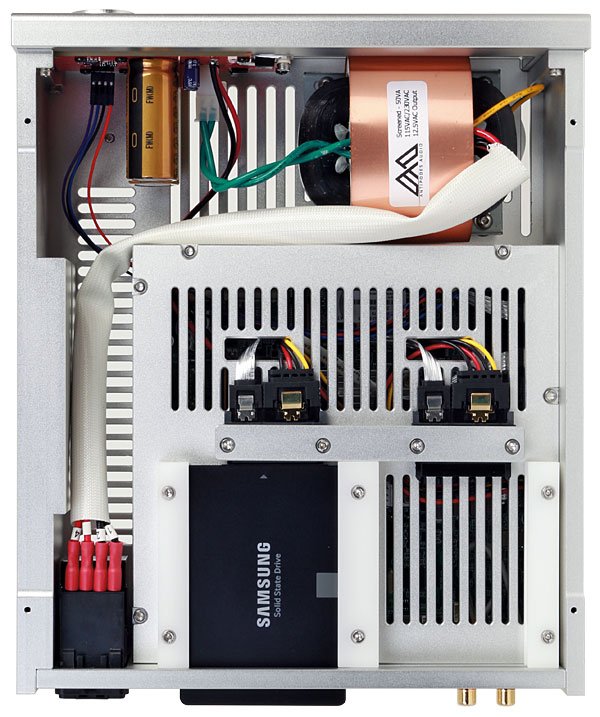
Playing the subtle synths of Vangelis’s Nocturne album [Decca 7702214], the precision of the sound via the Mojo was immediately ear-grabbing, as was the detail in the sweeps of synthesised backing. The same effect was very much in evidence with Lux Prima by vocalist Karen O and Danger Mouse, where the singer’s voice stands out with stunning character from the lush instrumentation. To sum up at this point, were I to listen to the EX alone, used with its analogue output, I might be a tad disappointed. However, even with the addition of a few hundred pounds of USB DAC, it’s completely transformed, becoming a viable alternative to the likes of the Melco range.
View the analogue outputs purely as a staging point to that, and they make perfect sense – after all, the analogue capability is already on the motherboard. As a Roon core, the EX struggled a bit with my massive music library stored on an external NAS. This would suggest the route preferred by Antipodes of using a CX to serve the content, and the EX purely as a renderer, also makes sense. Certainly things became smoother and faster with my separate Roon ROCK server running on an Intel i5 NUC, and the EX as the Roon endpoint, with all the ‘heavy lifting’ taken away from the Antipodes unit.
That done, and running straight into the Krell K-300i’s digital input, it gave a bright and breezy view of Sarah Bareilles’s Brave Enough live set [Epic 88883 77360 9], the bass having fine weight and slam and the vocals excellent character. As did the keen live audience and the singer’s banter with the crowd. Impressive, too, was the punch of Depeche Mode’s ‘Personal Jesus’, from the Violator set [Mute CD Stumm 64], the big, stomping rhythm section sounding especially toothsome.
Hi-Fi News Verdict
The score here reflects the mildly lacklustre performance of the EX’s analogue outputs, even when the manufacturer offers what is essentially a disclaimer. However, used as a purely digital source this ‘Music Server’ is both a fine example of its kind and a hint of what may be possible when we come to test a complete CX/EX combination. Use it as ‘transport’ for a USB DAC and you’re unlikely to be disappointed.
Antipodes Control Panel
The EX is remarkably flexible, with a choice of server modes including DLNA, Squeezelite and Roon, as well as the ability to operate as a renderer or endpoint in a number of configurations. It can also be set to act just as a server or a renderer, or as both. There’s a web-based GUI accessible from a browser on the same network, but more clarity wouldn’t go amiss in both that interface and the manual, which is also an online-only affair.
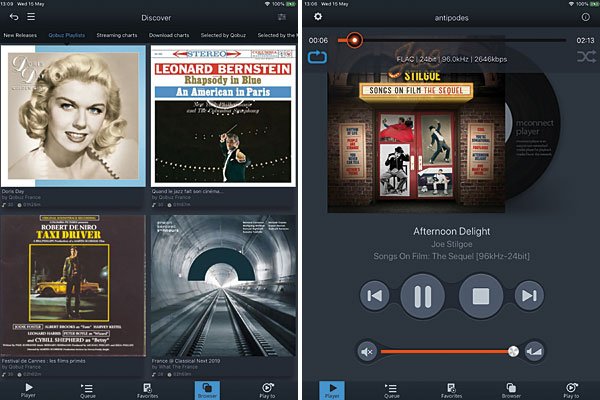
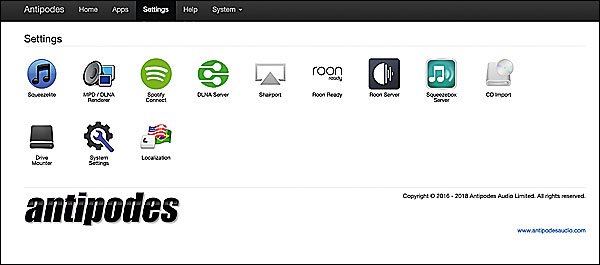
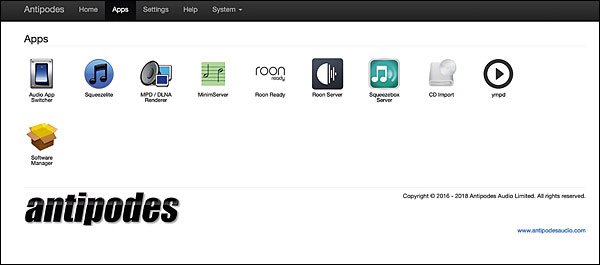
It’s rather too easy to get lost as to which software packages are running, which can lead to some clashes and confusion, and some facilities are hidden away. It was only when wondering why we couldn’t ‘see’ the EX with other network players that we found MinimServer buried in a submenu. Fortunately once set up, the EX can be operated by third-party control apps, such as the mConnect we used for much of the testing or, if relevant, Roon Remote running on a smartphone or tablet.
Lab Report
Equipped with a quad-core Celeron processor, the EX is rated by Antipodes as a fine renderer but with a reduced server capability compared to the CX with its Intel i7 on board. However, the ‘entry-level’ EX has the advantage of offering a one-stop solution for first-timers thanks to its 2V (line level) DAC output. This is not a Cirrus, TI or ESS DAC but an integated function of the motherboard’s Realtek audio hub. This is the first time we have tested a ‘mobo’ audio output, and its performance is none too shabby. Although Realtek specifies the part as 24-bit, this refers to wordlength handling rather than achievable resolution because the 96dB A-wtd S/N ratio and ±0.8dB error in linearity at –100dBFs suggest a practical performance of around 16 bits.
However, what is mainly ‘white’ noise is subjectively preferable to a more granular noise populated with digital spuriae and, indeed, this also serves to bury any correlated jitter to <10psec at all sample rates from 44.1kHz to 192kHz [see Graph 2]. Clock accuracy, meanwhile, is within Class 1 specification at –27ppm. There is some (analogue) stress on the op-amps over the top 20dB of the EX’s dynamic range where 2nd-15th harmonics push up to a modest 0.011% through bass and midrange and 0.016% at high (20kHz) frequencies. Lowest distortion is achieved at –15dBFs (0.0016-004%, 20Hz-20kHz), but all frequencies follow a very consistent ‘pattern’ with changing level [see Graph 1, below]. The linear phase digital filter provides 53dB of stopband rejection (re. 48kFs) and offers a very flat reconstructed response, extending to ±0.06dB up to 20kHz with 44.1/48kHz media, –2.1dB/45kHz with 96kHz files and –2.8dB/90kHz with 192kHz digital sources. PM
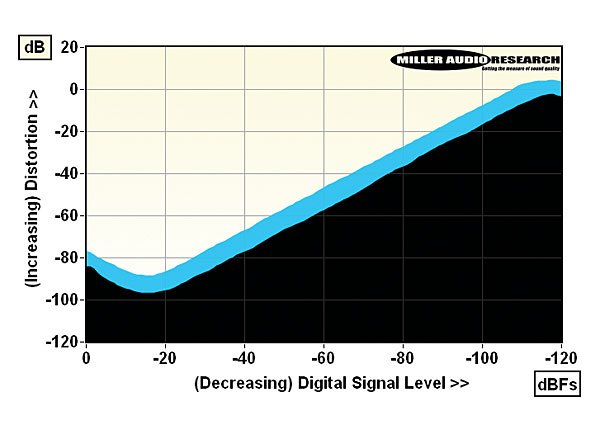
Distortion versus 48kHz/24-bit digital signal level over a 120dB dynamic range (from supplied SSD storage at 1kHz, black; 20kHz, blue)
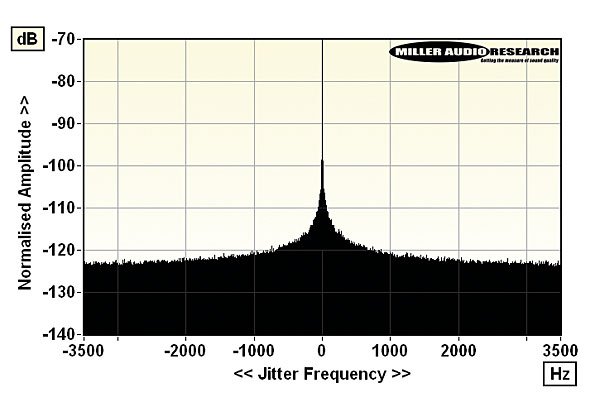
High resolution 48kHz/24-bit jitter spectrum (from supplied internal SSD storage)
Maximum output level / Impedance2.0Vrms / 73ohm
A-wtd S/N ratio96.3dB
Distortion (1kHz, 0dBFs/–30dBFs)0.011% / 0.0045%
Distortion & Noise (20kHz, 0dBFs/–30dBFs)0.016% / 0.014%
Freq. resp. (20Hz-20kHz/45kHz/90kHz)+0.0 to –0.1dB/–2.1dB/–2.8dB Digital jitter (48kHz/96kHz/192kHz)<10psec / <10psec / <10psec
Low-level resolution (@ –90dB/–100dB)±0.6dB / ±0.8dB
Power consumption14W (1W standby)
Dimensions (WHD) /Weight245x90x290mm / 7.5kg
